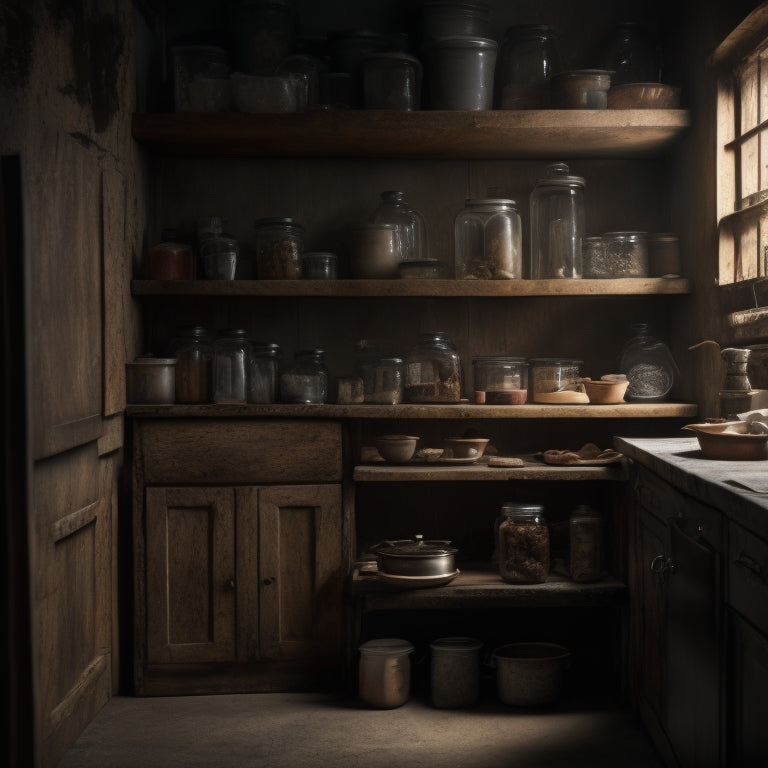
What's Hiding in Your Kitchen Cabinets Anyway?
Share
You open your kitchen cabinets expecting to find organized storage, but instead, you might uncover expired food and medications, toxic cleaning supplies, sharp objects, and unwanted pests. These hidden hazards can pose health risks, cause injuries, and contaminate your food and surfaces. Cluttered countertops, forgotten gadgets, and expired items can also be lurking in your cabinets. But there's more to discover - like overlooked storage spaces, pest infestations, and hidden clutter culprits. As you take a closer look, you might be surprised at what else you'll find, and how a few simple changes can transform your kitchen into a more harmonious and functional space.
Key Takeaways
• Expired food and medications, toxic cleaning supplies, and sharp objects can pose health risks and hide in kitchen cabinets.
• Forgotten gadgets, trendy kitchen tools, and bulky appliances can contribute to clutter and take up valuable space.
• Dirty dishes, appliances, and non-kitchen items can quickly accumulate on countertops, causing chaos and clutter.
• Cabinet shelves and back of cabinet doors can be optimized with shelf maximizers and dividers to increase storage capacity and organization.
• Pantry pests, broken appliances, and mystery containers can be lurking in kitchen cabinets, causing disorganization and health hazards.
Hidden Kitchen Cabinet Hazards
You likely open your kitchen cabinets multiple times a day, unaware of the hidden hazards lurking within, from expired food and medications to toxic cleaning supplies and sharp objects. These hazards can pose serious risks to your health and wellbeing if not addressed.
For instance, toxic chemicals in cleaning supplies can release harmful fumes, causing respiratory issues and skin irritation. Moreover, pest infestations like cockroaches and rodents can contaminate food and surfaces, spreading diseases.
It's essential to inspect your cabinets regularly to identify and eliminate these hazards. Start by checking expiration dates on food and medications, and dispose of anything past its prime. Next, switch to eco-friendly cleaning products that are free from toxic chemicals. Finally, keep your cabinets clean and dry to prevent pest infestations.
Common Kitchen Clutter Culprits
Now that you've tackled the hidden hazards in your kitchen cabinets, it's time to confront the clutter that's likely hiding in plain sight. You might be surprised at how quickly kitchen clutter can accumulate, making it difficult to find what you need when you need it.
One of the most common clutter culprits is Bulky Appliances. Those standby kitchen aids, like slow cookers and stand mixers, can take up valuable real estate on your countertops. Consider storing them in a designated area, like a appliance garage or a designated cabinet, to free up space.
Another offender is Forgotten Gadgets. We've all been guilty of buying a trendy kitchen gadget, only to use it once and then forget about it. Be ruthless – if you haven't used it in the past year, it's probably safe to get rid of it. Donate or recycle items that are still in good condition, and toss anything that's broken or no longer useful.
Kitchen Countertop Chaos Causes
Cluttered countertops are often the result of a few common habits, including leaving dirty dishes or appliances out, failing to put away ingredients and supplies after meals, and allowing mail, keys, and other non-kitchen items to accumulate in the kitchen.
These habits can lead to Countertop Clutter, making your kitchen feel chaotic and overwhelming.
You're not alone in this struggle. Many of us experience Morning Madness, where the kitchen becomes a hub of activity, and clutter builds up quickly.
To regain control, take a closer look at your daily habits and identify areas for improvement. Consider the following:
- Are you leaving dirty dishes or appliances out overnight?
- Are you putting away ingredients and supplies after meals?
- Are you designating a specific spot for non-kitchen items, like mail and keys?
- Are you wiping down the countertops after each meal to prevent crumbs and spills from building up?
Overlooked Cabinet Storage Spaces
Beyond the countertops, your kitchen cabinets hold hidden opportunities for storage and organization, waiting to be tapped into. You might be surprised at how much space you can reclaim by optimizing your cabinet storage.
Take a closer look at your cabinet shelves, for instance. Are they cluttered with stacks of plates, bowls, and cups? Consider investing in shelf maximizers, which can double or even triple your storage capacity. These clever devices allow you to stack items vertically, freeing up valuable space for other essentials.
Another often-overlooked area is the back of your cabinet doors. By installing cabinet dividers, you can create separate compartments for items like spices, oils, or cleaning supplies. This keeps them organized, easily accessible, and out of the way.
By maximizing these overlooked storage spaces, you'll be able to store more, stress less, and create a more harmonious kitchen environment that makes you feel like a pro.
Uninvited Kitchen Cabinet Guests
Your kitchen cabinets may be harboring unwanted guests, including expired food, broken appliances, and mysterious containers, which can clutter your storage spaces and make meal prep a frustrating experience. These uninvited guests can lead to pest infestations, forgotten heirlooms, and a general sense of disorganization.
Some common unwanted guests you might find in your kitchen cabinets include:
-
Pantry pests: cockroaches, ants, and rodents attracted to expired or open food
-
Forgotten kitchen gadgets: broken appliances, single-use tools, and mystery devices taking up valuable space
-
Mystery containers: unmarked or unlabeled containers hiding unknown substances
- Dusty decorations: forgotten heirlooms or decorative items collecting dust and taking up room
Frequently Asked Questions
Can I Reuse Old Kitchen Cabinet Organizers for New Layouts?
You can definitely reuse old kitchen cabinet organizers for new layouts, but consider design flexibility and potential cabinet revamp costs before deciding, as it may be more cost-effective to invest in new, tailored solutions.
How Often Should I Clean My Kitchen Cabinets From Top to Bottom?
When tackling Kitchen Revamps, you'll want to clean your cabinets from top to bottom every 2-3 months to maintain your Cabinet Creations' functionality and appearance, ensuring a clutter-free cooking space that feels like home.
Are Drawer Dividers Effective for Organizing Kitchen Utensils?
You'll find drawer dividers effective for organizing kitchen utensils if you categorize utensils by type (e.g., baking, cooking, serving) and choose dividers made from durable materials like wood, metal, or sturdy plastic that can withstand daily use.
Can I Store Kitchen Cleaning Supplies in a Bathroom Cabinet?
You're not alone in seeking storage solutions: 75% of homeowners admit to cluttered spaces. Storing kitchen cleaning supplies in a bathroom cabinet can work, but be mindful of bathroom real estate and avoid cabinet overcrowding.
Should I Replace or Refinish My Outdated Kitchen Cabinets?
You're facing a design dilemma: should you replace or refinance your outdated kitchen cabinets? Consider your budget, desired aesthetic, and functionality needs for a cabinet revamp that fits your style and meets your daily kitchen demands.
Related Posts
-

Affordable Amazon Home Improvement Must-Haves
You're one step away from a more organized, stylish, and functional living space! Start with must-haves like mDesign'...
